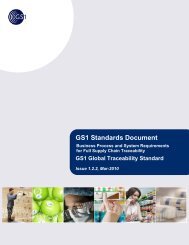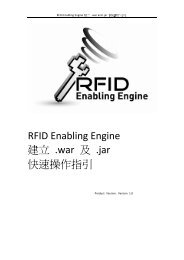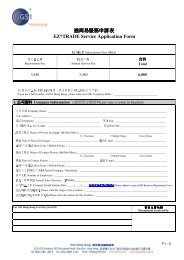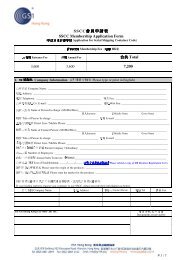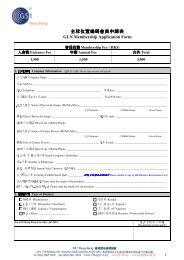Wine Supply Chain Traceability - GS1
Wine Supply Chain Traceability - GS1
Wine Supply Chain Traceability - GS1
You also want an ePaper? Increase the reach of your titles
YUMPU automatically turns print PDFs into web optimized ePapers that Google loves.
<strong>Wine</strong> <strong>Supply</strong> <strong>Chain</strong> <strong>Traceability</strong>established for transport and/or storage, which need to be managed throughout thesupply chain. The SSCC provides an unambiguous identification for logistic units(e.g. a flexi tank or a container). All parties in the supply chain can use it as areference number to the relevant information held in electronic or human readablefiles.4.4. Application Identifier (AI)Attribute information is any variable information required over and above the tradeunit or logistics unit identification, such as a batch number, production date orcustomer purchase order. In the <strong>GS1</strong> System, this information is expressed bymeans of <strong>GS1</strong> Application Identifiers (AI). Attribute information is bar coded in the<strong>GS1</strong>-128 bar code symbol.4.5. Bar Codes and RFID<strong>GS1</strong> bar codes allow automatic data capture of <strong>GS1</strong> numbers, which is a keybusiness solution in an efficient supply chain. The <strong>GS1</strong> numbering and bar codingsystem allows fast accurate and timely data input into computer systems,automating the flow of information into business processes. It also enablesimproved data capture and transfer of information, while reducing costs. Recent<strong>GS1</strong> standardisation developments in the field of RFID are internationally known asthe EPCglobal Network.For more information, please see http://www.epcglobalinc.org/Page 7 of 28
<strong>Wine</strong> <strong>Supply</strong> <strong>Chain</strong> <strong>Traceability</strong>The <strong>Wine</strong> <strong>Supply</strong> <strong>Chain</strong>Page 8 of 28
<strong>Wine</strong> <strong>Supply</strong> <strong>Chain</strong> <strong>Traceability</strong>5. The <strong>Wine</strong> <strong>Supply</strong> <strong>Chain</strong> ModelThe wine supply chain has always been complex and fragmented and with moredistant suppliers and ever-more demanding customers, the unique characteristics ofthis supply chain bring challenges to implementing an effective traceability system.The largest companies account for a significant percentage of the industry and havesignificant technology requirements. The remainder of the industry is comprised ofsmall to medium enterprises, many of which have found niches in specialty productsand branding. There is also a myriad of other support companies that providematerials, transportation, storage and other services that are also impacted bytraceability.Companies vary greatly in their technical capabilities; from phone, fax and paperbased transactions, through robust e-commerce, bar code, and other internalsystems. Their ability to identify implicated product, and perform track and traceactivities is directly related to their technical capabilities.The Working Group determined that the wine supply chain could be broken downinto the following key areas:oooooooGrape Grower<strong>Wine</strong> ProducerBulk DistributorTransit CellarFiller / PackerFinished Goods DistributorRetailerEach area was examined with a view to explaining traceability within that businessprocess, and to determine the relevant <strong>GS1</strong> standards to be deployed.5.1. Key Area 1: Grape Grower5.1.1. ScopeThe grape grower is responsible for the production (in accordance with integratedproduction principles), harvest and delivery of the grapes, as well as record keepingof appropriate information about what is received and what is sent. Vineyardtreatment details should be available on request.5.1.2. DescriptionSince traceability does not confer a guarantee of quality, disciplined record keepingis a key success factor. It is essential that the grower keep records for each plot orblock of vines under his control. This includes details about the location, type andcare of the vines, annual production record, origin and chemical content of waterused for cleaning and irrigation, and the annual treatment record, which includes allfertilisers, pesticides, fungicides and/or any other treatments carried out. On receiptof treatment products from suppliers, a record should be made of the supplier‟sdetails, a description of the product received, as well as applicable batch numbers.Page 9 of 28
<strong>Wine</strong> <strong>Supply</strong> <strong>Chain</strong> <strong>Traceability</strong>The records should also show where in the winery the grapes or juice were sent, forexample, to the de-stemmer/crusher/must chiller/press, maceration or receivingtank.Additives 1 :On receipt of additives from suppliers, a record should be made of the supplier‟sdetails, receiving date, a description of product received, as well as applicable batchnumbers.5.2.3. <strong>Traceability</strong> DataThe transformation from juice to wine can require numerous steps, but all wine ismade using the same basic process. Many procedures and operations areperformed, so the wine producer must keep accurate records of the proceduresused to make each wine. These records are the corner stone of product traceability.Physical samples of the finished product (per batch) may be retained for laterchemical analysis. The responsibility to maintain full traceability records (byemploying internal systems and procedures) rests with the business operator. Thenature of internal business processes, which form the basis for a risk analysis,remains the prerogative of each business operator. The winery is responsible foridentifying each production run with a batch number. Through the use of <strong>GS1</strong>standards, the business operator is able to accurately identify to whom the finishedproduct was delivered, isolate a distinct batch and withdraw it from the market.The finished wine may be sent to:□□□A filler/packer for the filling and packing of finished goods (trade items)Another wine producing cellar for inclusion as “top-up” or for blendingA bulk wine distributor5.2.4. <strong>GS1</strong> Standards• Identification of the <strong>Wine</strong> Producer:□The <strong>Wine</strong> Producer is identified by a GLN.• Product Identification (trade item):□A product (trade item) is uniquely identified with a Global Trade ItemNumber (GTIN). Since the product at this stage is deemed to be avariable measure item, the use of a variable measure indicator “9” isnecessary.• Shipping Container Identification (logistics unit):□A shipping container (e.g. road tanker) is identified with a SerialShipping Container Code (SSCC).• The quantity of wine dispatched:□The Application Identifier AI (315n) is used to indicate the quantity(litres) of wine dispatched. 212Any non-grape addition included in the wine-making process.The fourth (and last) digit of the AI indicates the implied decimal point position.The value 0 means that the measurement is expressed in the basic unit ofmeasure associated with the AI (e.g. litres). A value of 1 decreases themeasurement by a factor of 10, a value of 2 by a factor of 100, and so onPage 11 of 28
<strong>Wine</strong> <strong>Supply</strong> <strong>Chain</strong> <strong>Traceability</strong>• The batch number of each product:□The AI (10) is used to indicate the batch number. The quantitydispatched and batch numbers are both attributes of the product.Therefore they must be combined with the product identifier (GTIN, AI(01)).5.3. Key Area 3: Bulk Distributor5.3.1. ScopeThe bulk distributor is responsible for receipt, storage, dispatch, processing,sampling and analysis of bulk wine, as well as record keeping of appropriateinformation about what is received and what is dispatched.5.3.2. DescriptionThe bulk distributor receives bulk wine from the wine producer, which has beenidentified by a GTIN and a batch number. The bulk wine container identification(SSCC) is recorded on arrival. The information received and recorded also includesthe amount of wine received (AI (315n)).The wine is usually pumped into transport containers such as road tankers orbarrels. When the wine arrives at the “tank farm”, the bulk distributor checks thereceiving documents and takes samples for tasting and analysis. He approves orrejects the wine (if rejected, the wine returns to the nominated source). Two distinctprocesses are then identified:• Storage and dispatch of bulk wine without any blending or any otherprocessing. The batch number of the output is the same as the batchnumber of the input.• Storage, blending of different wines and dispatch of the new bulk blend. Anew batch number must be allocated, which is different from any other batchnumber used in the blending process.5.3.3. <strong>Traceability</strong> DataThe bulk distributor sends batches of wine to the transit cellar or to the filler /packer. Identification is handled as per the options detailed below.5.3.4. <strong>GS1</strong> StandardsBulk wine containers, such as storage tanks, are identified with a Serial ShippingContainer Code (SSCC) allocated by the bulk distributor. When bar coded, theSSCC is represented in a <strong>GS1</strong>-128 symbol. The AI (00) indicates that the data fieldcontains an SSCC.• Option One:□ The bulk wine container holds mixed products, with mixed batchnumbers.□The mandatory AI is (00) – Serial Shipping Container Code (SSCC).Page 12 of 28
<strong>Wine</strong> <strong>Supply</strong> <strong>Chain</strong> <strong>Traceability</strong><strong>GS1</strong> Company PrefixSerial Shipping Container Code (SSCC) bar coded in a <strong>GS1</strong>-128 symbol• Option Two:□The bulk wine container carries the same product, with the same batchnumber. The recommended Application Identifiers are:(00) – Serial Shipping Container Code (SSCC)(01) – Global Trade Item Number (GTIN)(10) – Batch code(315n) - Volume (litres)The SSCC and attribute information bar coded in a <strong>GS1</strong>-128 symbolPage 13 of 28
<strong>Wine</strong> <strong>Supply</strong> <strong>Chain</strong> <strong>Traceability</strong>5.3.5. <strong>Traceability</strong> Process• Identification of the Bulk Distributor:□A bulk distributor is identified with a GLN.• Identification of the Bulk <strong>Wine</strong> Container (SSCC, GTIN, Batch and Quantity):□It is essential that links between the SSCC of the container, the GTINand batch number of the product be maintained. To ensure forwardtracking, it is necessary to record the GTIN and Batch number of thedelivery items and link these to the GLN of the recipient. The informationregarding the SSCC and its components must be sent to the relevantsupply chain partners prior to the dispatch of the goods. This informationis then recorded for retrieval when the container arrives at itsdestination.5.4. Key Area 4: Transit Cellar5.4.1. ScopeThe transit cellar is responsible for the receipt, storage, dispatch, processing,sampling and analysis of bulk wine, as well as record keeping of appropriateinformation about what is received and what is dispatched. The transit cellar can bepart of the filler/packer company (geographically separate or not) or can beoutsourced. What differentiates the bulk distributor from the transit cellar is that theformer has a commercial role (he sends invoices) whereas the latter has only a roleof transit with no commercial and no invoicing goal.5.4.2. DescriptionThe transit cellar receives bulk wine from bulk distributors in different kinds ofcontainers. Each of these containers is identified with an SSCC, a GTIN and abatch number in a <strong>GS1</strong>-128 bar code, as well as in human readable form.During the transit cellar stage, the wine is prepared for onward sale and filling. It isloaded for transit to the customer and is accompanied by all the appropriatedocuments. The transit cellar sends batches of bulk wine to the filler/packer. Eachcontainer sent is identified with a unique serial number (SSCC), a GTIN, a batchnumber and the quantity of wine (litres) sent. This information is communicated viaa <strong>GS1</strong>-128 bar code and in human readable form. If the transit cellar is part of acellar complex, then the wine is moved through pipes to the filling section, ratherthan in bulk containers.5.4.3. <strong>Traceability</strong> DataIn order to maintain accurate traceability throughout the chain, it is necessary thatthe transit cellar records the GTIN and batch numbers, as well as the SSCC of eachitem dispatched.5.4.4. <strong>GS1</strong> Standards• Identification of the Transit Cellar□A transit cellar is identified with a GLN.• Identification of a container□A container is identified with an SSCC.Page 14 of 28
<strong>Wine</strong> <strong>Supply</strong> <strong>Chain</strong> <strong>Traceability</strong>• Product identification□A product is identified with a GTIN.• The quantity of wine dispatched□ The AI (315n) is used to indicate the quantity (litres) of wine dispatched.• The batch number of each product□ The AI (10) is used to indicate the batch number.5.4.5. <strong>Traceability</strong> ProcessTo ensure forward tracking, it is necessary to record the SSCC, GTIN and Batchnumber of the shipped items and link these to the GLN of the recipient. Acorrelation between the containers received by the transit cellar (SSCC, GTIN andbatch numbers at arrival) and the items dispatched to the finished goods distributor(SSCC, GTIN and batch numbers at departure) must be established.5.5. Key Area 5: Filler / Packer5.5.1. ScopeThe filler/packer is responsible for the receipt, storage, processing, sampling,analysis, filling, packing and dispatch of finished goods, as well as record keepingof appropriate information about what is received and what is dispatched.5.5.2. DescriptionThe filler/packer receives containers of bulk wine from the transit cellar or the bulkdistributor. Each of the containers of bulk wine is identified with an SSCC, a GTINand a batch number (carried in a <strong>GS1</strong>-128 bar code and in human readable form).“Dry goods” in contact with wine (bottles, caps, corks, etc) are also received, andtherefore each logistics unit must be also identified with an SSCC, GTIN and abatch number. Additional information regarding these items must be recorded (i.e.information on the water used to wash the filling equipment, chemicals used forcleaning, etc).A link between these components (bulk wine, finished product) should bemaintained. During this stage, the wine is filled into different kinds of containers,such as bottles, bags, kegs or barrels. Consumer units are produced from winebatches supplied, and a lot number is allocated to them 3. The next step is thepackaging of the consumer units into cartons and pallets or other logistic units.5.5.3. <strong>Traceability</strong> DataThe filler/packer dispatches cartons (identified with a GTIN and lot number) andlogistic units (identified with a SSCC) to the finished goods distributor. The lotnumber of the consumer unit must be linked to the batch(es) of bulk wine used to fillthe bottles. The recommendations concerning the identification and labelling ofconsumer units, cartons and logistic units are as follows;3While the lot number of the consumer unit refers to the filling line, the batch refersto the bulk wine blend used to fill the bottlesPage 15 of 28
<strong>Wine</strong> <strong>Supply</strong> <strong>Chain</strong> <strong>Traceability</strong>5.5.4. <strong>GS1</strong> Standards5.5.4.1. Trade items crossing the point of sale (bottle, can, jug, bag in box)These must be identified with a GTIN and bar coded with an EAN/UPC symbol forscanning at point-of-sale. Some countries, including EU member states, require thedisplay of a lot number allocated to each consumer unit created during the fillingprocess. This information may be displayed in human readable form.5.5.4.2. Trade items that may be crossing the point of sale (case, carton)• Option One:Trade items, specifically cases and cartons, sold through a retail point of sale areidentified with a GTIN and bar coded with an EAN/UPC symbol. For traceabilitypurposes, an add-on bar code symbol should be applied. This would be AI (10)indicating a lot number, encoded in a <strong>GS1</strong>-128 symbol. The preferred placement foran add-on <strong>GS1</strong>-128 bar code symbol is on the same horizontal plane as the primaryEAN/UPC bar code symbol containing the GTIN. The <strong>GS1</strong>-128 add-on symbolshould be as close as possible to the main symbol. Maintain the quiet zones forboth symbols.Example of Option One: EAN/UPC and <strong>GS1</strong>-128 add-on bar code• Option Two:For cases and cartons that will never be sold through a retail point of sale,identification is done through the use of Application Identifiers (01) (GTIN) and (10)(Lot Number), and encoded in a <strong>GS1</strong>-128 bar code.Example of Option Two: <strong>GS1</strong>-128 bar codePage 16 of 28
<strong>Wine</strong> <strong>Supply</strong> <strong>Chain</strong> <strong>Traceability</strong>NOTE: Should the filler/packer be uncertain where the product is to be distributedand sold (either through a retail point of sale or only in a warehouse environment), itis recommended that Option One (the EAN/UPC and <strong>GS1</strong>-128 add-on bar codessymbols) be used.5.5.4.3. Logistic units (pallets)Identification and traceability of pallets is ensured through the allocation of a SerialShipping Container Code (SSCC). Any pallet, independently of its type (mixed oruniform), needs to carry a SSCC allocated by the filler/packer. A new SSCC mustbe allocated every time a new logistic unit (pallet) is created.<strong>GS1</strong> LOGISTICS LABELEAN.UCC LOGISTICS LABELSSCC0 0614141 1234567890CONTENTCOUNT00614141000418 20BEST BEFORE ( ddmmyy ) BATCH14.02.05 4512XA(02 )00614141000418(15)050214(10)4512XA(37)20( 0 Example 0 ) 0 0 6 of 1 a 4 <strong>GS1</strong> 1 4 1 Logistics 1 2 3 4 5 Label 6 7 8 9 0The <strong>GS1</strong>-128 bar code and the use of Application Identifiers allows the filler/packerto include any additional information that may be required. A link must be made andmaintained between the SSCC and the identification numbers of the cartons itcontains (i.e. GTIN and lot number). It is recommended that the format of the <strong>GS1</strong>Logistics Label be used.5.5.5. Tracking ProcessTo ensure forward tracking, it is necessary to record the SSCC, GTIN and lotnumber of the shipped items and link these to the GLN of the recipient.5.6. Key Area 6: Distribution5.6.1. ScopeThe finished goods distributor is responsible for the receipt, storage, inventorymanagement and dispatch of finished goods, as well as re-packing and re-labellingPage 17 of 28
<strong>Wine</strong> <strong>Supply</strong> <strong>Chain</strong> <strong>Traceability</strong>as required, quarantining products, and record keeping of appropriate informationabout what is received and what is despatched.5.6.2. DescriptionThe finished goods distributor receives pallets and cartons from the filler/packer.These trade items and logistic units are identified with GTIN plus lot numbers, andSSCC, which are recorded. The finished goods distributor may also re-pack and relabelthe products as per specific customer requirements. The finished goodsdistributor dispatches cartons and pallets to the retailer. These trade items andlogistic units possess the same identification as when received (if the configurationis unchanged) or a new SSCC if the logistics container is re-packed. Should cartonsbe broken down and then re-used to pack specific orders, then the originalidentification on the carton must be obscured, and a new SSCC allocated by thefinished goods distributor to identify the new carton configuration.5.6.3. <strong>Traceability</strong> Data and <strong>GS1</strong> Standards• SSCC of the inbound pallet and GLN of its supplier• SSCC of the outbound pallet, either unmodified or newly created• Links between the SSCC of the newly created pallet and the SSCC of thepallets used in its creation and, if applicable the GTIN and lot number ofeach carton shipped to the retailer• GLN of the retail location to which the pallet is dispatched5.6.4. Tracking ProcessTo ensure forward tracking, it is necessary to record the SSCC, GTIN and LotNumber of the shipped items and link these to the GLN of the recipient.5.7. Key Area 7: Retail5.7.1. ScopeThe retailer receives pallets and cartons from the finished goods distributor andpicks and dispatches goods to the retails stores.5.7.2. DescriptionThe SSCC of an incoming pallet is recorded and linked to the GLN of the supplier.Each time the pallet is moved within the retail distribution centre, its SSCC isrecorded and linked to the GLN of its new location. The SSCC of an unmodifiedpallet picked for distribution from the storage area or cross-docked without anystorage is recorded and linked to the GLN of its destination. A newly created palletcontains cartons originating from different pallets. In this case, a new SSCC isassigned to it and linked to SSCC numbers of all other pallets used in its creationand/or, if applicable, the GTIN and Lot Code of each carton used. This can createthe need for an enormous effort and can be solved through the application of a“time window”, to be defined by each company, when a product is packed. Newlycreated pallets during this time window can be linked to pallets used up within thesame time frame. The SSCC is recorded and linked to the GLN of its destination.Page 18 of 28
<strong>Wine</strong> <strong>Supply</strong> <strong>Chain</strong> <strong>Traceability</strong>6. Best Practice Foundation Elements6.1. Data AlignmentSome companies already have effective internal traceability systems in place. Thenext step is to achieve full supply chain traceability. The main requirements forhandling product withdrawals 4 and recalls 5 across the supply chain are havingreliable data, the possibility to exchange the data and properly mapped businessprocesses. A good internal traceability system is a prerequisite to a chaintraceability system. The investments in an internal traceability system will not bewasted in moving towards chain traceability. All good supply chain traceabilitysoftware should be able to integrate seamlessly to any internal system. Theapplication of <strong>GS1</strong> standards is a prerequisite for the alignment of traceabilitysystems.The reason for using <strong>GS1</strong> standards is to overcome the barriers to commerce thatnational, industry and company specific standards create when they are used inplace of international multi-industry standards. Trading, tracking and tracing goodsbecome more expensive because of the need to fulfil different identification andcommunication requirements of each importing country or company. The key todesigning cost-effective and efficient traceability systems is to satisfy differentcustomer and legal requirements by applying one global standard.Companies that implement collaborative best practices and <strong>GS1</strong> standards need toencourage their partners to do the same. Before any <strong>GS1</strong> bar code label can bescanned, there has to be an exchange of master data between the trading partners.This data defines the specific trade item, such as its GTIN; the logistic unit, such asits SSCC; and the trading partner details, such as its GLN. Because this informationis retrieved from the receiver‟s files, it is crucial that the receiver is able to maintainthe necessary <strong>GS1</strong> data standards in its database. As the full product data is builtfrom both the sender and receiver‟s information, it is vital that the data is aligned.Therefore, it is very important that data alignment occurs prior to any physicaltransaction between the sender and receiver.6.2. Bar Code Print QualityAlthough technical improvements are continuously being made, printing <strong>GS1</strong>-128bar codes onto corrugated boxes does not provide the optimal scanning quality (interms of the combination of the quality of the corrugated board and/or the quality ofthe printing devices). Therefore, <strong>GS1</strong>-128 bar codes are currently printed ontolabels, which are then applied onto the corrugated box.6.3. Migration to <strong>GS1</strong> StandardsIn a supply chain where many trading partners are involved it is important to investin technology that supports properly aligned product identification and traceabilityprocesses to ensure that the full potential benefits of the investment can be45A procedure to withdraw products from the market where they have left theimmediate control of the brand ownerA procedure to withdraw products from the market where they have left theimmediate control of the brand owner and where they may have reached theconsumerPage 20 of 28
<strong>Wine</strong> <strong>Supply</strong> <strong>Chain</strong> <strong>Traceability</strong>achieved. Manufacturers and retailers, large and small companies can participate.Achieving proper alignment is the main driver for recommending companies toassess their current position and to consider implementing best practice asdescribed in <strong>GS1</strong> standards 6 .Throughout this process a collaborative approach is recommended includingdialogue between all supply chain partners. This dialogue will lead to theidentification of all essential supply chain information and material flows to bereceived, handled and generated within a company‟s boundaries and at interfacesbetween the company and its trading partners (e.g. at receiving and dispatch ofmaterials and finished goods). The important information that must be properlyrecorded and exchanged includes:• Identification of all supply chain partners through unambiguous coding usingthe Global Location Number (GLN)• Identification of all unique products using the Global Trade Item Number(GTIN)• Identification of logistic units using the Serial Shipping Container Code(SSCC)• Bar coding of trade items and logistic units with appropriate <strong>GS1</strong> bar codes• Precise and cost efficient electronic data interchange using standardelectronic message formats (EANCOM ® or <strong>GS1</strong> XML)A clear analysis should be completed to identify and describe the current status ofyour company organisation, IT systems and business processes (“as is”) and ananalysis should be prepared to describe the desired future status (“to be”). Theanalysis of the current practices of the wine supply sector and their expected futuredevelopment are to be taken into account in order to assess the timeframe neededto reach a critical mass of players for implementation. This will help identify anddocument the steps required to implement a migration programme and achieve asuccessful implementation of standards including:• Organisational changes• Investments in technology• Integration of new technology process designsThe final key step in the migration plan is to find the best sequence in which toimplement the solution, starting with organisational change and driving intotechnological implementation whilst preserving the benefits achieved through eachstep of the process improvements. All steps developed should be documentedincluding investment, impact and expected improvements and results. Anestablished timeline taking account of legislation, coupled with sound economicanalysis is the backbone of the migration plan.6.4. Self Assessment ScorecardA self-assessment scorecard should be developed to measure the degree ofcompliance and implementation of best practice. This self-assessment can bepresented as a checklist with a score that indicates the degree of implementation6GEPIR allows our members to use the Internet to look for a company (by itsGLN), a product (by its GTIN) and shipment identification (by its SSCC). Formore information, please see www.gepir.orgPage 21 of 28
<strong>Wine</strong> <strong>Supply</strong> <strong>Chain</strong> <strong>Traceability</strong>achieved. The following example can be further expanded or reduced depending oneach company‟s objective.Level 1: Identification and Labelling of ProductsScore*a. Products are identified as appropriate using <strong>GS1</strong> bar code standards at eachlevel of product hierarchy and step in the supply chain (e.g. consumer unit, box,and pallet).b. Logistic units are labelled using <strong>GS1</strong> bar code standards in pack houses andwarehouses.c. Clear information profiles are exchanged upstream and downstream to supplychain partners to ensure end-to-end traceability of products including raw material,ingredients, packaging materials, etc.d. Risk Assessments have been completed to identify and minimise risk withinproduction and supply chain processes.Level 2: Scanning Capabilities combined with Electronic Information Flowa. Bar Code Scanning capabilities are implemented in pack houses andwarehouses to ensure accurate data capture and improved material andinformation handling (e.g. scanning of incoming pallets)b. A flow of information, which describes the goods dispatched / received, isexchanged with trading partners (i.e. electronic flow of information supported by theDispatch Advice message).c. The flow of information on dispatched / received goods contains all the relevantinformation for traceability.d. The flow of information on dispatched / received goods is processed „just in time‟to achieve accurate data integration. This principle also applies to paper basedinformation processing.Level 3: Data Recordinga. All stock movements are recorded electronically and in an internal centraliseddatabase in such a way that the information can be accessed easily and rapidly byall the people who need it to help manage an incident / crisis. Paper basedsolutions must comply with the same conditions as described for electronic datarecording.* The scores could be based on the following suggestion:0 = No action taken1 = Plans have been established but the work has not started2 = Implementation has started with a limited scope (e.g. some product categories)3 = Rollout of the full implementation has started4 = Plans fully implemented6.5. Electronic Dispatch AdviceThe Dispatch Advice is an EDI message specifying details for the goods dispatchedwith the function of advising the receiver (consignee) of the detailed contents of aconsignment. The message relates to a single dispatch point and a single orPage 22 of 28
<strong>Wine</strong> <strong>Supply</strong> <strong>Chain</strong> <strong>Traceability</strong>6.7. Stock Withdrawal and Product RecallWithdrawing or recalling a product is an organisational procedure that relies onaccurate information extracted from the internal traceability system / database andrequires close collaboration between all the parties involved. Food safety andquality assurance functions control the status of the products and communicatethese to supply chain distribution, which is responsible for applying this status andtreating the products accordingly.The objective of a lot withdrawal process is to prevent availability of the product atthe point of sale. Lot withdrawal requires total control of the stock. This means thatall supply chain partners implicated in the stock withdrawal process must be able tocorrectly identify the product (i.e. GTIN, SSCC) and the batch/lot code involved, itslocation and the quantity stored there. The traceability process ensures that thetrade partners can answer these questions.Best practice for stock withdrawal is based on the following principles:• Stock withdrawal management is based on the logistic units using the SSCCas the identifier• Pallet contents are identified using the product identification (GTIN) andbatch/lot codes• Pallet tracking within the area controlled by the brand owner means frominternal / external origin to internal / external destination• Targeted withdrawal at destinations, which have or may have received theaffected goods that need to be withdrawn• Companies must define procedures for the identification of blocked goods,communication and instructions for withdrawal• Regular training and periodical exercises<strong>Traceability</strong> of wine at batch/lot level ends at the retail distribution centre. Batch/lottracking forward in the retail distribution centre is complex and expensive due to itslarge portion of mixed pallets sent to the points of sale and received from suppliers.Due to the lack of tracking in the retail distribution centre, all the stores of theimplicated retailers must be included in the recall. The brand owner must thereforeassume that the product is already available at the point of sale and initiate a recallafter delivery to the retail distribution centre. Depending on the nature and severityof the quality or safety issue, a recall could include the involvement of tradeassociations and broadcasting information to all potential consumers via massmedia. The implicated product and batch/lot must be identified and exchanged if notalready consumed.6.8. Developing Internal Competencies and SkillsRegular training should be given to all the employees, who may be involved inproduct traceability, incident and crisis management. The scope of this trainingshould include:• <strong>Traceability</strong> processes implemented by the company, based on the bestpractice documented in this document• Instruction on incident / crisis management• Role of the Incident / Crisis Management Team• Role of the person being trained• Whom to contactPage 24 of 28
<strong>Wine</strong> <strong>Supply</strong> <strong>Chain</strong> <strong>Traceability</strong>• The importance of coordinated actions and communication within thecompany• What to do and what to avoid doing• How to use the traceability documentation• How to use internal product traceability and record systemsThe training should also include simulated exercises on:• Crisis Management• Product <strong>Traceability</strong>• Product withdrawal• Product recall• Management of quarantined stockPage 25 of 28
<strong>Wine</strong> <strong>Supply</strong> <strong>Chain</strong> <strong>Traceability</strong>codes representing the above numbers and/or EANCOM ®messages.EDI or <strong>GS1</strong> XML• What does it cost to become a member of a <strong>GS1</strong> Member Organisation?Membership costs vary from one country to another and in general depend on thenumbering capacity of the <strong>GS1</strong> company prefix and the services required. Themembership fees usually consist of an annual fee and a one-time joining fee.• What do I get in return?A member company receives a <strong>GS1</strong> Company Prefix, a capacity to number itsproducts and basic support in implementing the <strong>GS1</strong> system. The numberingcapacity given to member companies depends on their requirements. Should acompany wish to use EDI via EANCOM ® messages, it can request the necessaryinformation and manuals from its national <strong>GS1</strong> Member Organisation.• How do I administer the number bank allocated to me by a <strong>GS1</strong>Member Organisation?When you join a <strong>GS1</strong> Member Organisation, it will provide you with the necessarydocumentation to administer the numbering system. It is advisable that allcompanies centrally allocate product numbers.• How do I print <strong>GS1</strong> bar codes on labels?Label composition software should permit you to use desktop laser or ink jetprinters, or you can use specially designed high performance thermal direct orthermal transfer printers. These may be self-contained units able to print preprogrammedlabel formats, or may require the use of a personal computer.• Do I have to become a member of a <strong>GS1</strong> Member Organisation in everycountry I operate in?No. One <strong>GS1</strong> Member Organisation membership should meet all the identificationand communication needs of a company. However, if there is a need for continuous<strong>GS1</strong> Member Organisations support in other countries (i.e., in the local language) itis then advisable to seek membership in those countries too.• Do I need to become a member of a <strong>GS1</strong> Member Organisation to use<strong>GS1</strong>-128?Yes. Membership in a <strong>GS1</strong> Member Organisation is required to use <strong>GS1</strong> datastructures. These data structures are represented in <strong>GS1</strong> data carriers (bar codes).If you are not already a member of a <strong>GS1</strong> Member Organisation, you will have toapply for membership if you wish to use <strong>GS1</strong>-128. If you are already a member of a<strong>GS1</strong> Member Organisation, your annual membership fee includes supportconcerning all <strong>GS1</strong> standards, including <strong>GS1</strong>-128.• Is <strong>GS1</strong>-128 used only to identify pallets?No, it is being used for the identification of trade units, identification and trackingand tracing of logistics units (mainly pallets) and assets, as well as encoding ofadditional information, such as batch numbers, production or best before dates, etc.Many other applications also utilise the <strong>GS1</strong>-128 standards and symbology.Page 27 of 28
<strong>GS1</strong>Avenue Louise 326, bte 10B-1050 Brussels BELGIUMT +32 2 788 78 00F +32 2 788 78 99W www.gs1.orgPage 28 of 28



